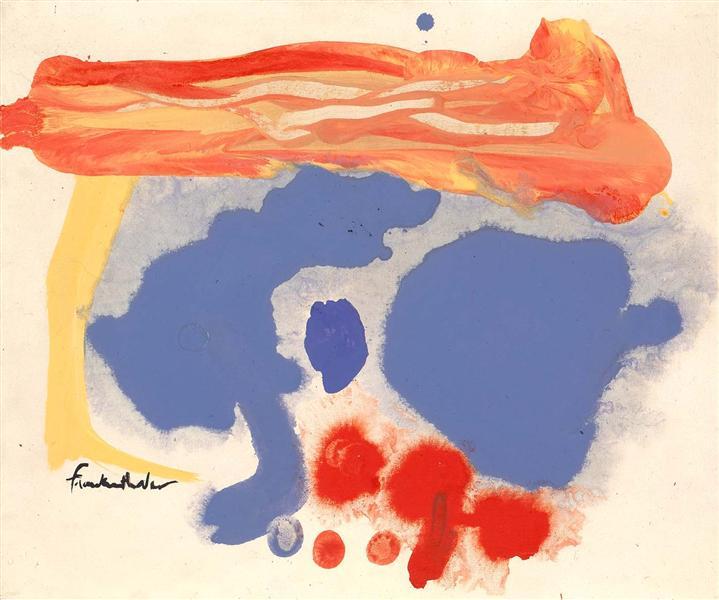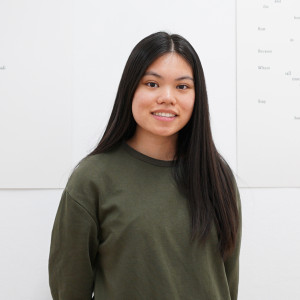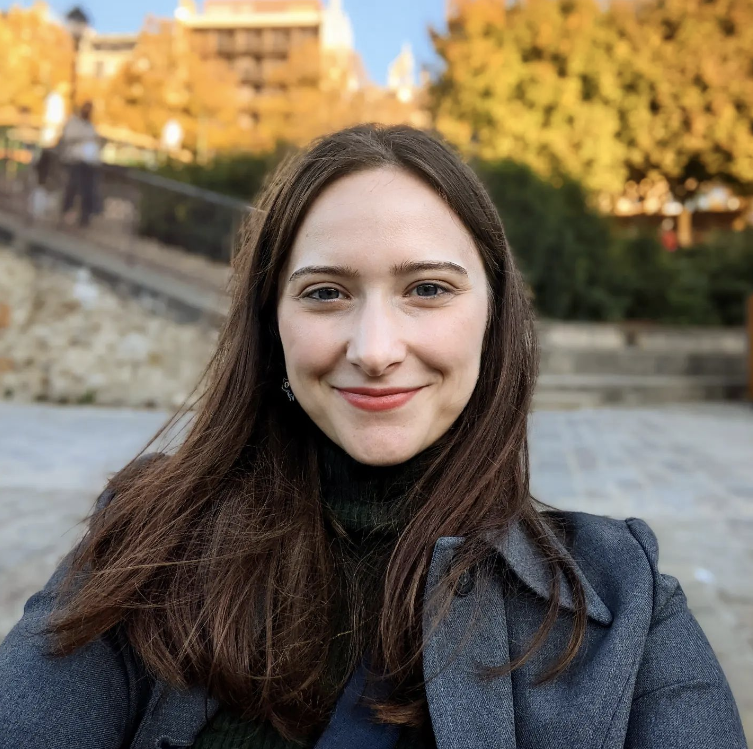In a postwar America, the landscape of Western art changed. Frankenthaler was an experimentalist with her art, which contributed to and helped drive the American art movements in the 1950s. Discover how Frankenthaler’s innovative techniques meshed with art as a whole in the 20th century.

Who Was Helen Frankenthaler?
Born in New York City in 1928 to a wealthy family, Frankenthaler’s parents were fortunately business-savvy enough to avoid financial ruin in the 1929 stock market crash and subsequent Great Depression. She attended the prestigious Dalton School, where she learned from famed painter Rufino Tamayo, before attending the also prestigious Bennington College, where she learned from other famed artist Paul Feeley. Although she enjoyed art, she felt stifled by the Cubism and geometric styles of her teachers (as was in fashion at the time).
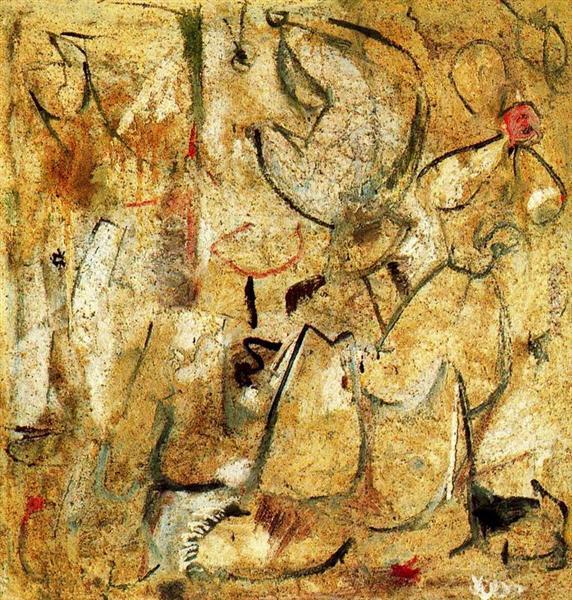
After finishing college in 1950, she met art critic Clement Greenberg while making her way in Manhattan’s modern art circle. The two began dating (which lasted 5 years), and he guided Frankenthaler in the world of professional art.
She took a summer course with famed abstract artist Hans Hofmann, which inspired her interest in art enough to create a few pieces worthy of exhibition.
But it wasn’t until 1951 that Frankenthaler truly found her muse, inspired by Abstract Expressionist artwork by Jackson Pollock. She was enamoured by Pollock’s drip-style, freeform, chaotic art. When recalling the moment she saw the art, she said
It was as if I suddenly went to a foreign country and didn’t know the language, but had read enough, and had a passionate interest, and was eager to live there. I wanted to live in this land; I had to live there, and master the language.
Helen Frankenthaler
After this spark of inspiration, Frankenthaler set to work inventing new ways to express herself with art. Her new techniques quickly sparked interest in other abstract artists and were seen as revolutionary.
While she received a fair amount of praise and recognition, she still, like many other female artists, including greats like Frida Kahlo, faced sexism. Many critics said her art was “good, for a girl.” Her 13-year-long marriage to fellow artist Robert Motherwell caused critics to frame her as “just a wife” whose art was only popular because of her famous husband.
Nevertheless, she continued creating warmly-received art, even after divorcing Motherwell, proving she was more than just the man she was with.
Frankenthaler rose in the art field as a standout leader among the second-generation postwar Abstract Expressionists.
She began participating regularly in international exhibitions, like the Première Biennale de Paris in 1959 (where she won first prize) and the 33rd Venice Biennale in 1966.
Of course, she also showed her work in many renowned spaces domestically, such as her 1960 exhibition at the Jewish Museum in New York and the Whitney Museum of American Art in 1969.
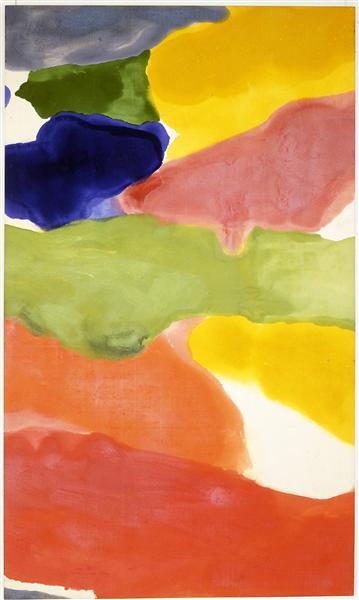
Later in her career, she continued to experiment with a wide array of media, including ceramics, sculpture, tapestry, and printmaking. As well as for her contributions to painting, Frankenthaler is especially renowned for her printmaking and woodcut expertise.
🎨 Find a fun and effective painting course Melbourne here on Superprof.
Frankenthaler’s Style and Techniques
Frankenthaler’s professional painting career was entirely within the Abstract Expressionist movement. She was inspired by Jackson Pollock, a first-generation Abstract Expressionist. Her innovative styles and techniques informed other artists in the Abstract scene to venture in more new directions.
Specifically, Frankenthaler is known for contributing in two major ways: inventing the soak-stain technique and providing a foundation for the Colour Field Painting Movement.
Soak-Stain Technique
Frankenthaler’s formative art education felt too limiting for her tastes, and it even made her almost give up on art entirely. The planned composition, the rules for colour and form, the delicate and deliberate nature of using brushes… all of it was contrary to the way she shone in painting; she just didn’t know it back then.
Inspired by Pollock’s erratic paintings that allowed the picture to just exist without deeper intellectual pressure, Frankenthaler eventually had her own breakthrough about spilling paint. In a moment of “impatience, laziness, and innovation,” she decided not to stretch and size an enormous canvas, not prime it, and instead apply oil paints diluted with turpentine straight to the fabric laid out on the studio floor. That first experiment was named Mountains and Sea (1952).
She was more concerned with how the painting looked, rather than what it was. The result was an almost purely conceptual work that sat within the canvas, rather than on top; a textural feat that piqued many artists’ and art critics’ interest.
This technique evolved over time, but its mere invention caused other Abstract artists to see new ways of navigating their expressions. Painter Morris Louis referred to Frankenthaler as “a bridge between Pollock and what was possible.”
In later works, Frankenthaler moved to watered-down acrylics instead of oil and turpentine, partly due to turpentine's tendency to damage the canvas over time. This development gave her paintings richer colour than before.
🎨 Find painting classes near me here on Superprof.
Colour Field Painting
The next development Frankenthaler made with her soak-stain technique was to dive into the world of Colour Field Painting. Colour Field Painting had been pioneered in the late 40s by several other Abstract Expressionists, so it was a rather new concept in Frankenthaler’s time, and hadn’t found its footing in the Abstract art sphere.
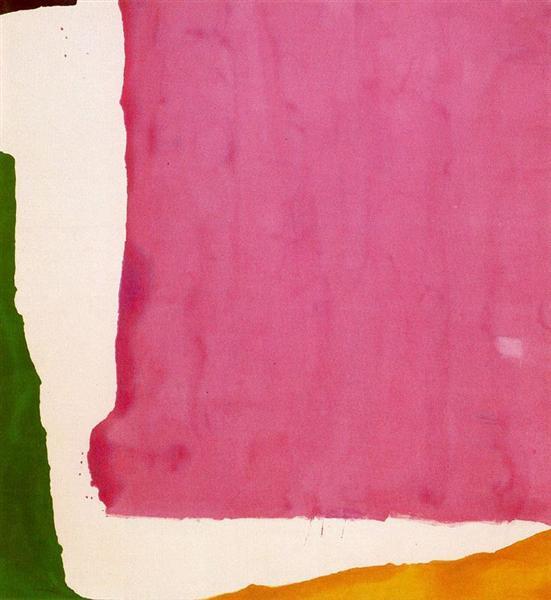
It emphasised colour over form and figuration, the intention being to evoke emotions associated with ancient myths, but without using any of the symbolism in traditional painting.
Flatness was crucial for avoiding influencing the viewer to see a specific thing before thoroughly evaluating the picture.
The ill-defined edges of the image or negative space suggest that the scene might continue on, past the canvas.
Frankenthaler’s art fit in perfectly with the Colour Field Painting credo. Encouraged by Greenberg, Frankenthaler co-developed Colour Field Painting into a distinct sub-style in Abstract Expressionism.

Most Famous Helen Frankenthaler Paintings
Frankenthaler’s long art career produced fewer works than some other female artists, such as Georgia O’Keeffe (144 paintings for the former and 2,000 for the latter). She is not well-known for her many famous paintings. Instead, Frankenthaler has a handful of recognisable pictures, each contributing to her pivotal contributions to modern art. She also created many other types of art, especially in her later years, so not all of her creative energy was spent on painting alone.
Mountains and Sea (1952)
The soaked-in colour creates a purely flat image, which was entirely new for a painting at that time. Other art styles use perspective and layering to create some kind of sense of position. Even other Abstract Expressionist art at the time had literal texture, like how Pollock’s enamel paints sat on top of the canvas in raised shapes.
About this work, Frankenthaler said the landscapes “were in my arms as I did it ... I was trying to get at something - I didn't know what until it was manifest." Her work was less about planning and trying to convey something to a future viewer, and more about exploring and allowing the paint to create something that resonated with an idea in her mind.
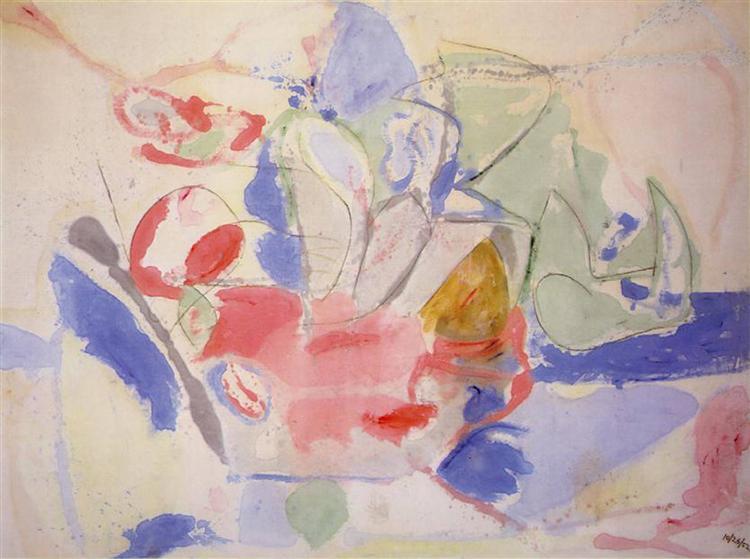
Jacob’s Ladder (1957)
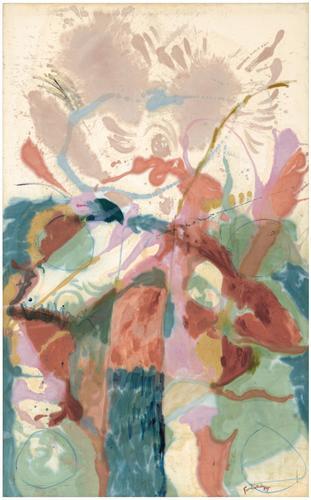
The Biblical tale of Jacob’s ladder tells of Jacob’s dream, wherein he imagines a ladder the angels use to easily traverse between Heaven and Earth.
Although Frankenthaler’s abstraction shows nothing at all like a ladder in the picture, one can see the suggestion of two different planes of existence.
Above are some faint, ghostly forms radiating energy (reminiscent of Biblically accurate angels).
Below is an overlap of solid forms with more translucent shapes, suggesting the intermingling of Heavenly beings with the Earth.
Artemisia Gentileschi is another famous female artist who often depicted Biblical scenes, though in a much more literal sense.
Canyon (1965)
After a few years, Frankenthaler changed her process from oil paint and turpentine to acrylic paint and water. This process gave her pictures a much richer colour, as seen here with the deep, vibrant rusty red and lush teal that make up the bulk of the work. As before, she would pour the diluted paint onto an unprimed canvas, allowing the colour to sink into the fibres. Part of the reason for the shift was perhaps as a response to critics insinuating that her work was a cheap, feminine knock-off of Pollock’s work.
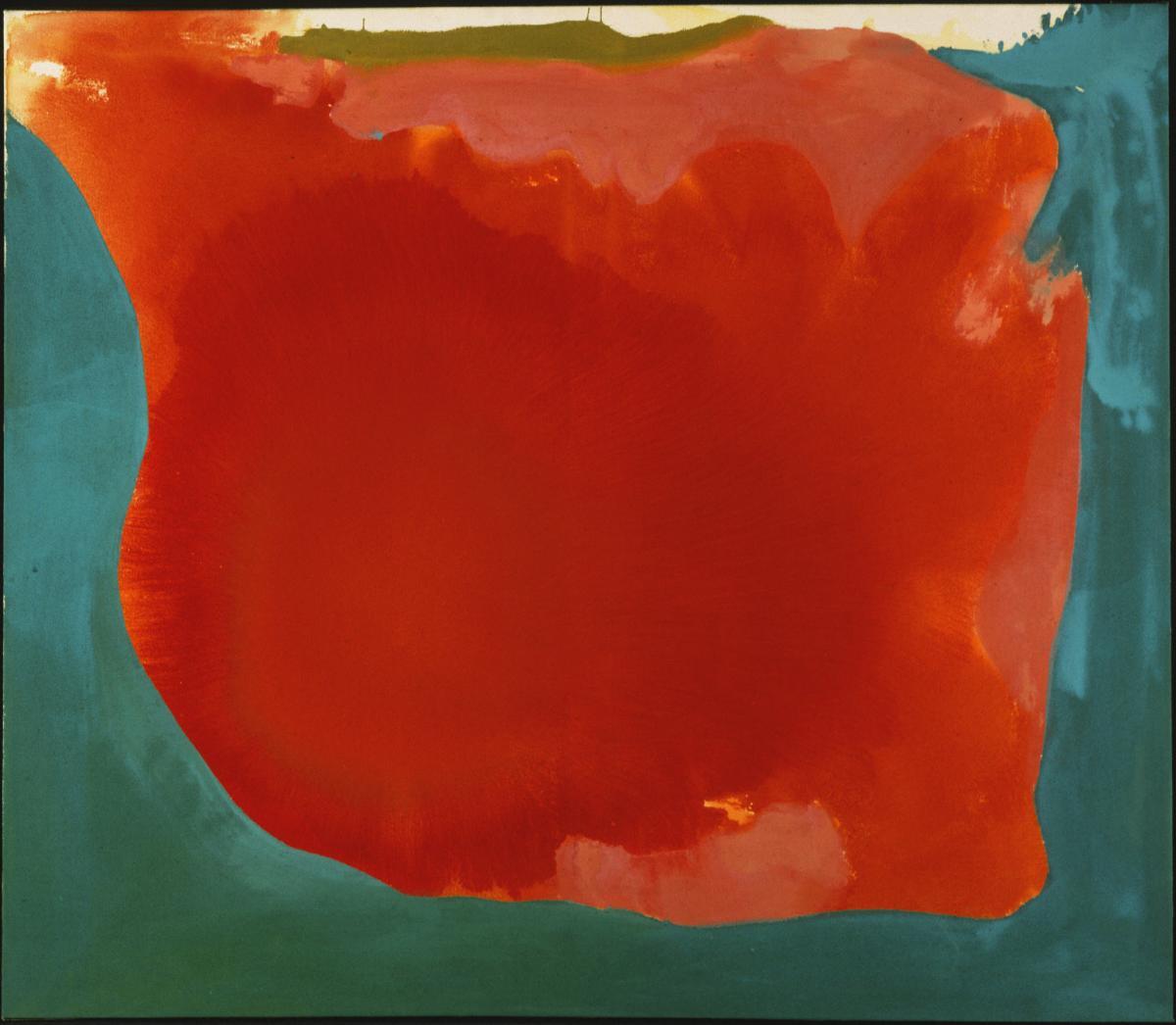
Grey Fireworks (1982)
Grey Fireworks is a contradiction in a few dimensions. The name itself is contradictory, and Frankenthaler has expressed means “It’s not grey dismal, it’s grey celebrative.” Out of the grey sky, perhaps hazy with humidity, or full of smoke from spent fireworks, or both, specks of light can be seen shining through. While not the bright, dazzling display we expect from fireworks, the implication is that light and dark can, or must, co-exist.
Learn all about art techniques with painting classes Perth here on Superprof.
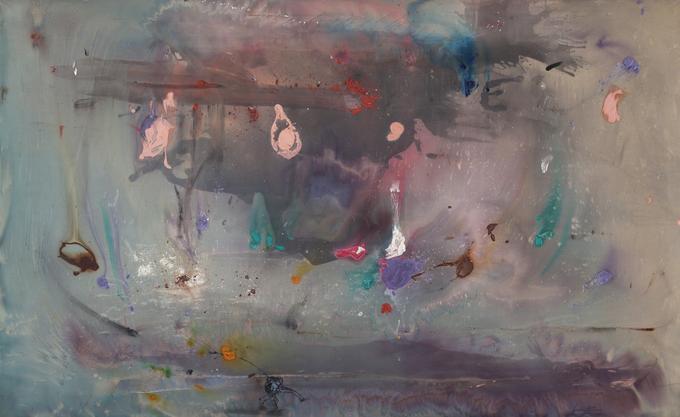
Frankenthaler’s Legacy
Unlike the majority of female artists throughout time, Frankenthaler was fortunate enough to live in a time and place where her work was thoroughly recognised and admired when it was made. Although she had her fair share of negative reviews from art critics, as does every artist, Frankenthaler also had plenty of people giving her and her work due respect.
Certainly, artists like Mary Cassatt would have been jealous of her immediate success and acceptance! In her lifetime, Frankenthaler was a member of numerous art boards, including the National Council on the Arts and the American Academy of Arts and Letters, and was even an Honorary Academician of the Royal Academy of Arts in London.
Her work has been studied, both in her lifetime and after, for its groundbreaking philosophical implications in art as well as its practical effects on the evolution of abstract art.
There are no rules... that is how art is born, that is how breakthroughs happen. Go against the rules or ignore the rules, that is what invention is about.
Helen Frankenthaler
In retrospect, many art critics and historians consider Frankenthaler one of the most important Abstract Expressionist painters.
Although Frankenthaler believed that gender shouldn’t be a factor when evaluating a person’s artistic talent and in fact described herself as “not a suffragette,” she is interwoven into women’s history.
She continued making art, including sculpture and woodcut prints, all throughout her life until her death in 2011. Frankenthaler was a great contributor to women's art history, along with many others.
References
- Biography - Helen Frankenthaler - Helen Frankenthaler Foundation. (n.d.). In www.frankenthalerfoundation.org. https://www.frankenthalerfoundation.org/helen/biography
- Color Field Painting Movement Overview. (n.d.). In The Art Story. https://www.theartstory.org/movement/color-field-painting
- Frankenthaler Paintings, Bio, Ideas. (n.d.). In The Art Story. https://www.theartstory.org/artist/frankenthaler-helen
- Greenberger, A. (2021). Helen Frankenthaler’s Liberated Abstractions Charted a New Path for Painting. In ARTnews.com. https://www.artnews.com/feature/helen-frankenthaler-who-is-she-why-is-she-important-1234586555
- Heavy Is the Root of Light. (2020). In After the Art. https://aftertheart.com/2020/06/18/heavy-is-the-root-of-light
- Helen Frankenthaler. (n.d.). In Canal. https://www.guggenheim.org/artwork/1348
- Hill, K. (2025). Keeping up with the Boys: Abstract Expressionist Helen Frankenthaler. In DailyArt Magazine. https://www.dailyartmagazine.com/keeping-up-with-the-boys-abstract-expressionist-helen-frankenthaler
- IN FOCUS Helen Frankenthaler. (n.d.). In Guggenheim Museum Bilbao. https://www.guggenheim-bilbao.eus/en/did-you-know/in-focus-helen-frankenthaler
- Nemerov, A. (2021). How a Moment of Crisis Led Helen Frankenthaler to Create an Iconic Artwork. In ARTnews.com. https://www.artnews.com/art-news/artists/helen-frankenthaler-fierce-poise-excerpt-1234586498
- The power of Helen Frankenthaler’s lyrical abstractions. (n.d.). In Art UK. https://artuk.org/discover/stories/the-power-of-helen-frankenthalers-lyrical-abstractions
- (N.d.). researchgate.net. https://www.researchgate.net/publication/364143748_Helen_Frankenthaler_-_The_Incredible_Lightness_of_Beauty

